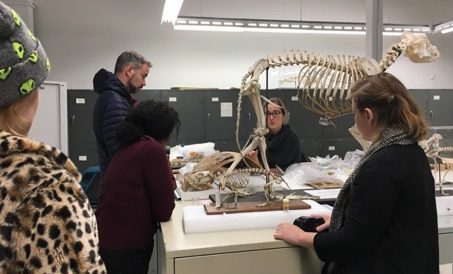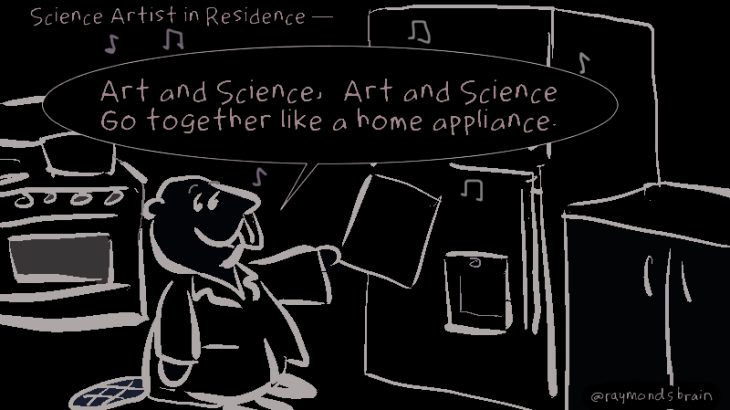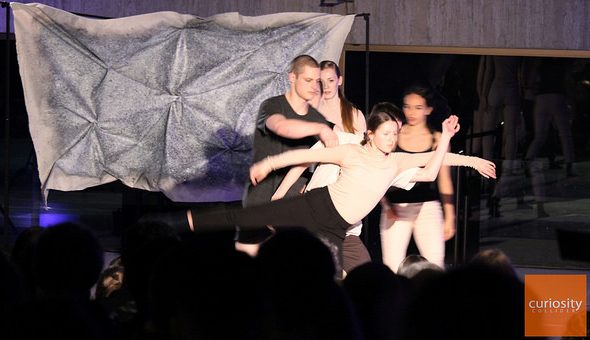Katrina Vera Wong and Raymond Nakamura, Multimedia co-editors
Melding art and science can be challenging, and often requires specialized knowledge, resources, and support. Some organizations are filling the gap by helping artists develop their scientific chops through courses or residencies. Artists can build on their scientific skills and knowledge, or gain access to scientific resources and facilities to produce new works.
Here are some opportunities available in Canada.
Programs paid for by artists

Ayatana residents at the Natural Heritage Building of the Canadian Museum of Nature in Quebec. Photo courtesy of Katrina Vera Wong
The Ayatana Artists’ Research Program is a week-long residency hosted in Gatineau, Quebec, that “leads visiting artists on a series of field trips and workshops to learn firsthand from scientists about their current research.” Artists may study “birds, bioacoustics, plants, insects, ecology, water, microscopy, death, evolution [or] mushrooms.” Since 2014, Director of Ayatana, Alexis Williams, has hosted 180 local and international artists in a shared “residency house,” where they enjoy home-cooked meals over stimulating conversations. “The potential for innovation spurred by these encounters [between art and science] is exciting and reassuring,” she says.
Nature has always been an inspiration to artists, though perhaps nowadays wilderness is harder to access. This is not so for the Canadian Wilderness Artist Residency. According to their website: “Every residency is an integrated immersion into areas of remote Canadian wilderness, tailored to emerging and practicing artists of any medium.” The inspiring experience of being in the wilderness with other creative people is discussed in this brief video.
Open Science Network describes itself as “Vancouver’s first Community Science Lab,” which mixes people of different backgrounds. They don’t offer a specific residency, but provide expertise and equipment, particularly in molecular biology, to anyone who pays to become a member. They are keen to support citizen science and the democratization of science.
Programs that pay artists
This year, the Faculty of Fine Arts and Ocean Networks Canada (ONC) at the University of Victoria (UVic) piloted an Artist-in-Residence Ocean Program. According to Dr. Susan Lewis, Dean of UVic’s Faculty of Fine Arts, the interdisciplinary program hopes “to broaden and cross-fertilize perspectives and critical discourse around oceans.” Customized to the selected artist’s concept and background – the inaugural recipient is Colton Hash – the program offers access to ONC’s “online resource of ocean data” and offshore expeditions (“where logistics permit”) according to Kim Juniper, Chief Scientist at ONC. The artist produces an exhibit at the end of the program that engages the public and inspires “other artists to bridge the gap between art and ocean science.”
Curiosity Collider is a Vancouver based non-profit organization that is committed to providing opportunities for artists whose work expresses scientific concepts and scientists who collaborate with artists.” They have an open call for artists and scientists to participate in their shows and events. Past events have included Quantum Futures, an “artistic journey into the counterintuitive realm of quantum mechanics” and Interstitial: Science Innovations by Canadian Women, an exhibition “profiling work and achievements by Canadian women in all fields of science” and exploring “the complex dynamics of gender in supposedly objective scientific industry.” They run cafes for people like us to present their interdisciplinary work (like the sciart zine we created for an earlier post).
Beakerhead is a big annual science-inspired festival in Calgary. They offer a “Big Bang” residency for a creative interdisciplinary team to create “an interactive public art work that references science, technology, and collective experience.” The 2018 winner featured lighting engineers who created Skybridge Syncopation. Last year, the winning team Humble Wonder developed a Municipal Space Station, involving hands-on exploration and virtual reality to create a futuristic space elevator experience.
The vision of the University of Guelph School of Environmental Sciences Artist Residency Program is “to bring Art and Science together to broaden possibilities, perspectives and critical discourse.” Current residents Sarah Jane Gorlitz and Wojciech Olejnik collaborate to “employ found objects, readily available materials, D.I.Y. methods, and experimentation to create videos, stop-motion animations and mixed media installations.” In 2015, Artist-in-Residence Annie Dunning created Sapsucker Sounds, “an installation of objects and interactive sound sculptures that offer an opportunity to experience sound generated by a conflation of human and woodpecker culture. “
The Pelling Lab creates “living, functional, biological objects that do not exist in nature” and includes artists in its works. As a result of her work with them, Elaine Whittaker developed an installation called Contained, based on her mother who contracted tuberculosis in the 1940s. Elaine told us, “The great thing about being an Artist-in-Residence in the Pelling Laboratory is being involved in their culture of cutting edge and upending science. Everyone there is welcoming, creative, funny, supportive and driven by unapologetic curiosity. The perfect place for an artist to thrive in.”
The Ontario Science Centre (OSC) and the Museum of Contemporary Art in Toronto have partnered to profile artists through Idea Projects. Maurice Bitran, CEO and Chief Science Officerof OSC, says, “In bringing different thinkers together, Idea Projectshighlights the potential power for scientific and artistic inquiry to change our cultural and societal landscapes.”
Did we miss any? Let us know! And please share your experiences with developing your science and art practice.
~30~






How about ‘Art the Science’? Actually I’m a bit surprised you didn’t include them since I found out about the group from you folks:)
We reached out to them but they’re still working out the details of their future residencies – definitely worth watching out for 😉
Hello Katrina,
We did not receive any emails from you about our residency program. Happy to discuss. We had a pilot one in March and conducted an evaluation as well see report here: https://artthescience.com/wp-content/uploads/2018/11/Science_Artist_Residency_Phase_I_Evaluation.pdf
Warmly,
Julia Krolik
Art the Science founder
How about the new Experimental Lakes Area one?
Also there’s the Scientifically Delirium Madness residency at Djerassi program with Leonardo/ISAST. https://www.leonardo.info/artist-scientist-residencies
*in California though